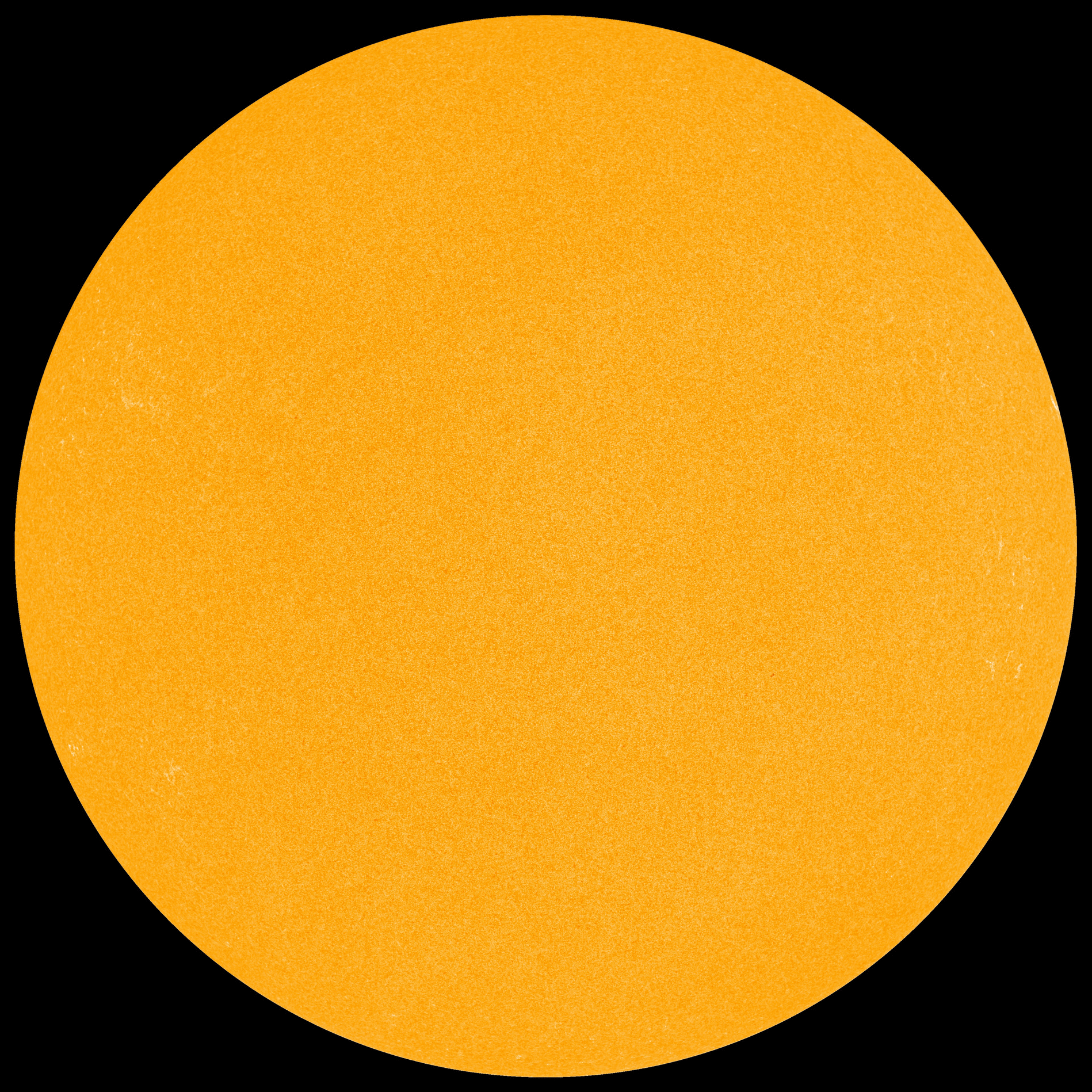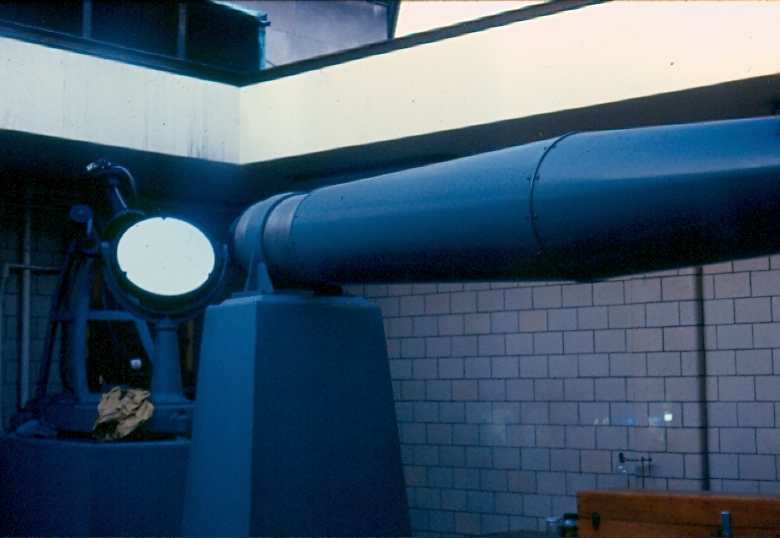
Photograph of a "blank Sun," with no sunspots on the side of the Sun facing the Earth, from June 4.
(Image Sources: NASA's Solar Dynamics Observatory, SpaceWeather.com)
By Glenn A. Walsh
Reporting for SpaceWatchtower
Solar Cycle 24, one of the weakest
sunspot cycles on-record, is nearing its minimum, with the first two
days with no visible sunspots since 2014 (which was the last year to
have one day with a “blank Sun” since 2011). Although two
sunspots were visible today (June 14), no sunspots were visible on
the side of the Sun visible from the Earth on June 3 and 4.
Sunspots are areas of intense magnetic
activity on the photosphere, or visible surface, of the Sun. These
areas appear dark, often black (central umbra) surrounded by a gray
area (penumbra), because sunspots are much cooler than the rest of
the Sun. Temperatures of sunspots measure between +4,892° and
+7,592° Fahrenheit / +2,700° and +4,200° Celsius, while the rest
of the Sun's visible surface has a temperature of about +9,932° Fahrenheit / +5,500°
Celsius.
Sunspots were first observed by the
famous Italian Astronomer Galileo Galilei in the early seventeenth
century. By 1755, an eleven-year sunspot cycle was recognized and
has been extensively observed ever since. With the first numbered
sunspot cycle, Solar Cycle 1, beginning in 1755, we are now observing
Solar Cycle 24.
Although a “blank Sun” for two days
this month does not mean we have reached the absolute low point in
the current sunspot cycle, it does mean we can expect the lowest
point of the cycle in the coming few years. At this point in time,
they predict that the low point in the cycle may come sometime in
2019 or 2020.
Our current sunspot cycle, Solar Cycle
24, has been observed as the weakest sunspot cycle in more than a
century. This cycle has had the fewest sunspots since Solar Cycle 14
peaked in February of 1906.
After more than seven years in Solar
Cycle 24, scientists have now determined that the peak of the cycle
(month with the most sunspots visible) came in April of 2014. This
peak slightly surpassed an earlier peak in March of 2012. Often
sunspot cycles have two peaks, however this is the first time that
scientists recorded the second peak as greater than the first peak.
The previous solar minimum phase, which was quite weak, occurred from
2007 to 2009.
As we approach the solar minimum for
this cycle, we must note that a smaller number of sunspots does not,
necessarily, mean the Earth will experience inactivity. During a solar minimum, the solar magnetic field weakens and
the solar wind decreases. This allows galactic cosmic rays to
penetrate further into the Solar System and get closer to the Earth.
This is a much more dangerous time for astronauts in Earth orbit or
beyond, as cosmic rays can damage human DNA.
Further, with fewer sunspots, the Sun's
extreme ultraviolet radiation (EUV) declines. This causes the Earth's
upper atmosphere to cool and contract. Now, this does reduce
aerodynamic drag on satellites in orbit, which reduces the need for
satellites, including the International Space Station, to use extra
fuel to prevent a premature deorbiting. However, it also means space
junk will stay in orbit longer, providing an additional danger to
astronauts.
With this new century bringing
significantly weaker sunspot cycles, this has brought to the Earth
lower-than-normal space-weather / geomagnetic storms. However, while
major solar storms are predicted to occur less often in such weak
cycles, some major storms can still occur. Indeed, it was during a
weak solar cycle (Solar Cycle 10 of 1855 to 1867), in 1859, when
Earth experienced the famous “Carrington Event.” During this
Solar Storm of 1859, Earth's magnetosphere was hit by a solar coronal
mass ejection. In addition to inducing one of the strongest
geomagnetic storms on-record, telegraph systems all over the Earth
failed, telegraph operators received electric shocks, some telegraph
systems sparked causing small fires, and bright aurorae were observed
closer to the equator than ever previously recorded.
And, there is some evidence that
stronger solar flares and geomagnetic storms are more likely to occur
while a solar cycle is waning. So such solar activity could still be
possible over the next couple of years.
Prolonged weak solar cycles can have a
cooling effect on average Earth temperatures. What scientists and
historians now refer to as the “Little Ice Age” occurred during
the low solar activity of the “Maunder Minimum,” which occurred
from 1645 to 1715, and the “Dalton Minimum,” which ran from 1790
to 1830,
Viewing of sunspot activity on the Sun
by the general public was often available, on sunny days in the
Astronomical Observatory of Pittsburgh's original Buhl Planetarium
and Institute of Popular Science. A large image of the Sun would be
projected onto a nearby projection screen from Buhl's historic
10-inch Siderostat-type Refractor Telescope. This rather unique
telescope, which also was used to view the Moon, planets, and stars
in both the daytime and nighttime skies, will be 75 years old on
November 19.
Links to Additional Information ---
More details with graphs:
Link >>> http://www.vencoreweather.com/blog/2016/6/4/300-pm-the-sun-has-gone-completely-blank
Daily Space-Weather Forecasts and Information, including information on sunspots:
Link >>> http://spaceweather.com/
More on sunspots: Link >>> https://en.wikipedia.org/wiki/Sunspot
More on the Carrington Event of 1859: Link >>> https://en.wikipedia.org/wiki/Solar_storm_of_1859
More on Galileo: Link >>> https://en.wikipedia.org/wiki/Galileo_Galilei
More on Buhl Planetarium's historic 10-inch Siderostat-type Refractor Telescope:
Link >>> http://spacewatchtower.blogspot.com/2016/01/astronomical-calendar-2016-january.html
Related Blog Posts ---
"Largest Sunspot in 24 Years Returns for 2nd Month." 2014 Nov. 23.
Link >>> http://spacewatchtower.blogspot.com/2014/11/largest-sunspot-in-24-years-returns-for.html
"Sunspot Count Max Finally Arrives, But 'Mini-Max.'" 2014 June 10.
Link >>> http://spacewatchtower.blogspot.com/2014/06/sunspot-count-max-finally-arrives-but.html
Sources:
Glenn A. Walsh Reporting for SpaceWatchtower, a project of Friends of
the Zeiss, Meteorologist Paul Dorian of Vencore, Inc.
2016 June 14.

2016: 75th Year of Pittsburgh's Buhl Planetarium Observatory
Link >>> http://spacewatchtower.blogspot.com/2016/01/astronomical-calendar-2016-january.html
Like This Post? - Please Share!
Want to receive SpaceWatchtower blog posts in your inbox ?
Send request to < spacewatchtower@planetarium.cc >..
gaw
Glenn A. Walsh, Project Director,
Friends of the Zeiss < http://buhlplanetarium.tripod.com/fotz/ >
Electronic Mail - < gawalsh@planetarium.cc >
SpaceWatchtower Blog: < http://spacewatchtower.blogspot.com/ >
Also see: South Hills Backyard Astronomers Blog: < http://shbastronomers.blogspot.com/ >
Barnestormin: Writing, Essays, Pgh. News, & More: < http://www.barnestormin.blogspot.com/ >
About the SpaceWatchtower Editor / Author: < http://buhlplanetarium2.tripod.com/weblog/spacewatchtower/gaw/ >
SPACE & SCIENCE NEWS, ASTRONOMICAL CALENDAR:
< http://buhlplanetarium.tripod.
Twitter: < https://twitter.com/spacewatchtower >
Facebook: < http://www.facebook.com/pages/
Author of History Web Sites on the Internet --
* Buhl Planetarium, Pittsburgh:
< http://www.planetarium.
* Adler Planetarium, Chicago:
< http://adlerplanetarium.
* Astronomer, Educator, Optician John A. Brashear:
< http://johnbrashear.tripod.com >
* Andrew Carnegie & Carnegie Libraries:
< http://www.andrewcarnegie.
* Civil War Museum of Andrew Carnegie Free Library:
< http://garespypost.tripod.com >
* Duquesne Incline cable-car railway, Pittsburgh:
< http://inclinedplane.tripod.
* Public Transit:
< http://andrewcarnegie2.tripod.

2016: 75th Year of Pittsburgh's Buhl Planetarium Observatory
Link >>> http://spacewatchtower.blogspot.com/2016/01/astronomical-calendar-2016-january.html
Like This Post? - Please Share!
Want to receive SpaceWatchtower blog posts in your inbox ?
Send request to < spacewatchtower@planetarium.cc >..
gaw
Glenn A. Walsh, Project Director,
Friends of the Zeiss < http://buhlplanetarium.tripod.com/fotz/ >
Electronic Mail - < gawalsh@planetarium.cc >
SpaceWatchtower Blog: < http://spacewatchtower.blogspot.com/ >
Also see: South Hills Backyard Astronomers Blog: < http://shbastronomers.blogspot.com/ >
Barnestormin: Writing, Essays, Pgh. News, & More: < http://www.barnestormin.blogspot.com/ >
About the SpaceWatchtower Editor / Author: < http://buhlplanetarium2.tripod.com/weblog/spacewatchtower/gaw/ >
SPACE & SCIENCE NEWS, ASTRONOMICAL CALENDAR:
< http://buhlplanetarium.tripod.
Twitter: < https://twitter.com/spacewatchtower >
Facebook: < http://www.facebook.com/pages/
Author of History Web Sites on the Internet --
* Buhl Planetarium, Pittsburgh:
< http://www.planetarium.
* Adler Planetarium, Chicago:
< http://adlerplanetarium.
* Astronomer, Educator, Optician John A. Brashear:
< http://johnbrashear.tripod.com >
* Andrew Carnegie & Carnegie Libraries:
< http://www.andrewcarnegie.
* Civil War Museum of Andrew Carnegie Free Library:
< http://garespypost.tripod.com >
* Duquesne Incline cable-car railway, Pittsburgh:
< http://inclinedplane.tripod.
* Public Transit:
< http://andrewcarnegie2.tripod.
No comments:
Post a Comment